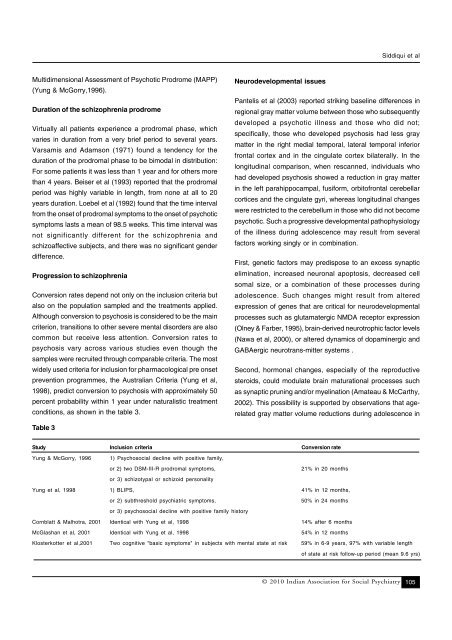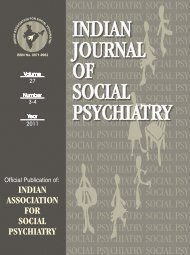IJSP-2010(3-4) - Indian Association For Social Psychiatry
IJSP-2010(3-4) - Indian Association For Social Psychiatry
IJSP-2010(3-4) - Indian Association For Social Psychiatry
Create successful ePaper yourself
Turn your PDF publications into a flip-book with our unique Google optimized e-Paper software.
Multidimensional Assessment of Psychotic Prodrome (MAPP)<br />
(Yung & McGorry,1996).<br />
Duration of the schizophrenia prodrome<br />
Virtually all patients experience a prodromal phase, which<br />
varies in duration from a very brief period to several years.<br />
Varsamis and Adamson (1971) found a tendency for the<br />
duration of the prodromal phase to be bimodal in distribution:<br />
<strong>For</strong> some patients it was less than 1 year and for others more<br />
than 4 years. Beiser et al (1993) reported that the prodromal<br />
period was highly variable in length, from none at all to 20<br />
years duration. Loebel et al (1992) found that the time interval<br />
from the onset of prodromal symptoms to the onset of psychotic<br />
symptoms lasts a mean of 98.5 weeks. This time interval was<br />
not significantly different for the schizophrenia and<br />
schizoaffective subjects, and there was no significant gender<br />
difference.<br />
Progression to schizophrenia<br />
Conversion rates depend not only on the inclusion criteria but<br />
also on the population sampled and the treatments applied.<br />
Although conversion to psychosis is considered to be the main<br />
criterion, transitions to other severe mental disorders are also<br />
common but receive less attention. Conversion rates to<br />
psychosis vary across various studies even though the<br />
samples were recruited through comparable criteria. The most<br />
widely used criteria for inclusion for pharmacological pre onset<br />
prevention programmes, the Australian Criteria (Yung et al,<br />
1998), predict conversion to psychosis with approximately 50<br />
percent probability within 1 year under naturalistic treatment<br />
conditions, as shown in the table 3.<br />
Table 3<br />
Neurodevelopmental issues<br />
Siddiqui et al<br />
Pantelis et al (2003) reported striking baseline differences in<br />
regional gray matter volume between those who subsequently<br />
developed a psychotic illness and those who did not;<br />
specifically, those who developed psychosis had less gray<br />
matter in the right medial temporal, lateral temporal inferior<br />
frontal cortex and in the cingulate cortex bilaterally. In the<br />
longitudinal comparison, when rescanned, individuals who<br />
had developed psychosis showed a reduction in gray matter<br />
in the left parahippocampal, fusiform, orbitofrontal cerebellar<br />
cortices and the cingulate gyri, whereas longitudinal changes<br />
were restricted to the cerebellum in those who did not become<br />
psychotic. Such a progressive developmental pathophysiology<br />
of the illness during adolescence may result from several<br />
factors working singly or in combination.<br />
First, genetic factors may predispose to an excess synaptic<br />
elimination, increased neuronal apoptosis, decreased cell<br />
somal size, or a combination of these processes during<br />
adolescence. Such changes might result from altered<br />
expression of genes that are critical for neurodevelopmental<br />
processes such as glutamatergic NMDA receptor expression<br />
(Olney & Farber, 1995), brain-derived neurotrophic factor levels<br />
(Nawa et al, 2000), or altered dynamics of dopaminergic and<br />
GABAergic neurotrans-mitter systems .<br />
Second, hormonal changes, especially of the reproductive<br />
steroids, could modulate brain maturational processes such<br />
as synaptic pruning and/or myelination (Amateau & McCarthy,<br />
2002). This possibility is supported by observations that agerelated<br />
gray matter volume reductions during adolescence in<br />
Study Inclusion criteria Conversion rate<br />
Yung & McGorry, 1996 1) Psychosocial decline with positive family,<br />
or 2) two DSM-III-R prodromal symptoms,<br />
or 3) schizotypal or schizoid personality<br />
21% in 20 months<br />
Yung et al, 1998 1) BLIPS, 41% in 12 months,<br />
or 2) subthreshold psychiatric symptoms,<br />
or 3) psychosocial decline with positive family history<br />
50% in 24 months<br />
Cornblatt & Malhotra, 2001 Identical with Yung et al, 1998 14% after 6 months<br />
McGlashan et al, 2001 Identical with Yung et al, 1998 54% in 12 months<br />
Klosterkotter et al,2001 Two cognitive "basic symptoms" in subjects with mental state at risk 59% in 6-9 years, 97% with variable length<br />
of state at risk follow-up period (mean 9.6 yrs)<br />
© <strong>2010</strong> <strong>Indian</strong> <strong>Association</strong> for <strong>Social</strong> <strong>Psychiatry</strong> 105



